Menu
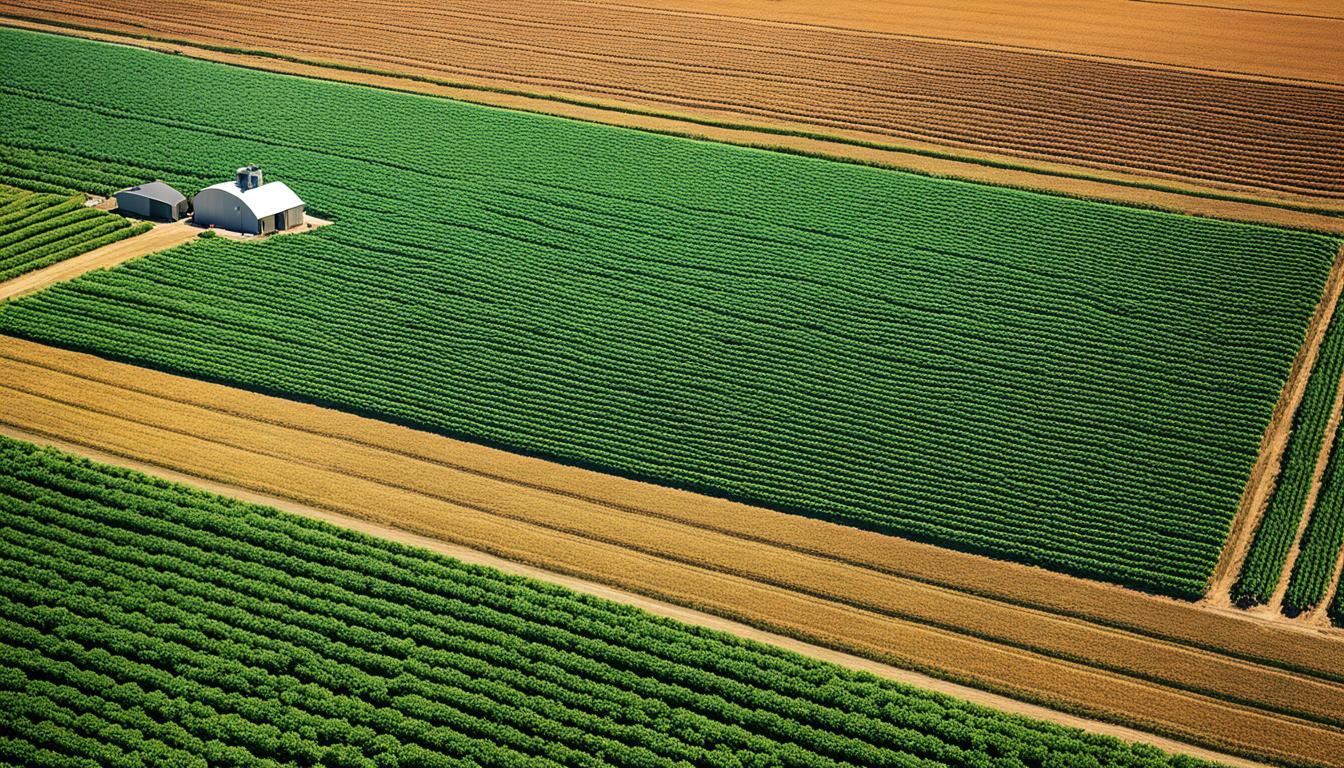
By 2050, farms might produce about 4.1 million pieces of data every day. The agriculture world is changing fast because of digital tools. Unfortunately, many tools out there don’t fit farm needs and end up unused. This shows the big gap in getting helpful, tailored agtech services for farms.
Digital tools play a key role in using resources better and growing more crops. They cover lots of tasks like keeping records, managing risks, and preventing losses. Being able to adjust these tools to fit each farm’s special needs helps farmers make right choices. This boosts how well the farm runs.
Some tools, like Soiltech, focus on being simple, easy to use, and change to fit what the farm needs. This focus on making tools for farmers’ specific needs is new. It’s about making technology that quickly becomes part of a farm’s routine. With the goal to produce more food by 2050, these customised digital tools for farms are key.
Digital tools are transforming agriculture, bringing traditional farming and modern efficiency together. These tools help farmers work better and control their farms more accurately. They led to many benefits, known as agricultural digitalisation benefits, for today’s farmers.
Digital farming has many uses. It helps with everything from tracking livestock to managing money. This makes running a farm much more manageable for farmers.
Vertical farms use up to 70% less water than traditional farms. The global greenhouse market is worth around US $350 billion. This shows how big an impact these new digital tools can have.
The precision agriculture market could reach $43.4 billion by 2025. This data comes from Grand View Research, Inc. Tools like xarvio FIELD MANAGER and ONE SMART SPRAY are helping. They offer services that make better use of resources. ONE SMART SPRAY has an accuracy rate of over 95%, just like older methods. Such precision helps farmers be both sustainable and profitable.
The benefits of farming technology advancements go beyond just working more efficiently. Tools like xarvio’s HEALTHY FIELDS ensure plant health, using lots of data and scientific models. With Field Monitor, farmers can watch what happens on their fields live. This helps them manage better and act quickly when needed.
Moving to more technology means farming smarter and better. Tailored solutions, like xarvio’s, offer advice that’s just right for each farm. This makes growing crops and using resources better. The benefits of using these digital tools are key for a successful and future-ready agriculture sector.
Agriculture software helps manage various farm tasks better and makes quick decisions easier. It puts all data in one place for things like keeping records, managing water, and controlling pests. Each type of software focuses on different farming needs. This helps farms run smoother, produce more, and make more money.
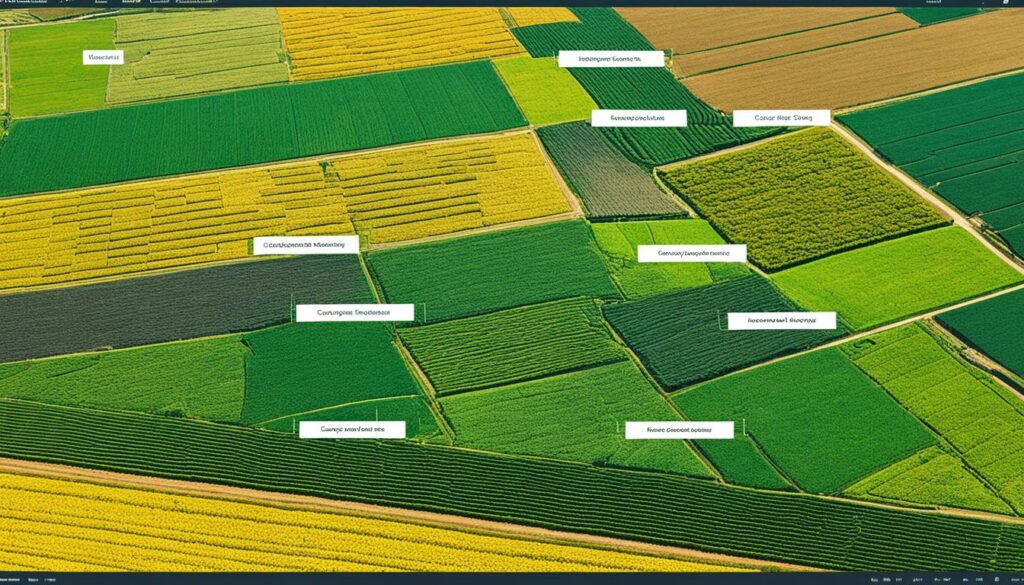
There are many types of agriculture software. Each one helps with different farming activities. Some important ones are:
Agriculture software has many benefits, especially in managing farms. It:
The variety of software and its benefits show how much agriculture is changing. These tools are key to producing more, saving money, and farming sustainably around the world.
Crop management software helps farmers track plant growth and predict harvests. It’s key for modern farming. These tools let farmers improve how they grow crops. They help meet farm goals sustainably.
Tracking plant growth is key. It lets farmers watch their crops’ progress in real-time. They can make changes to keep crops growing well. Eco Docs stands out by making it easy to collect and analyse plant growth data.
Estimating how much a farm will produce is crucial. Tools like AgriERP and Granular can predict yields. This info helps farmers get ready for market needs. It also makes their farming process more efficient and profitable.
| Software Name | Key Features |
|---|---|
| Eco Docs | Centralised data collection, in-depth analysis |
| AgriERP | Remote farm management, increased output and profitability |
| Croptracker | Rapid issue resolution, smooth audits |
| Granular | Economic advantages, outstanding client service |
| Traction | Accounting, payroll, field operations, agronomy |
| Agworld | Collaboration among workers at all phases |
| Agrinavia | Office and field work options, inventory management |
| Conservis | Real-time record keeping, cost tracking |
| Farmbrite | Farm and livestock management, easy integration |
| Trimble | Field mapping, seed monitoring |
Effective financial management is key for farms to stay afloat. This means making sure there’s enough money coming in to cover all costs. Farm accounting software helps farmers do this with ease.
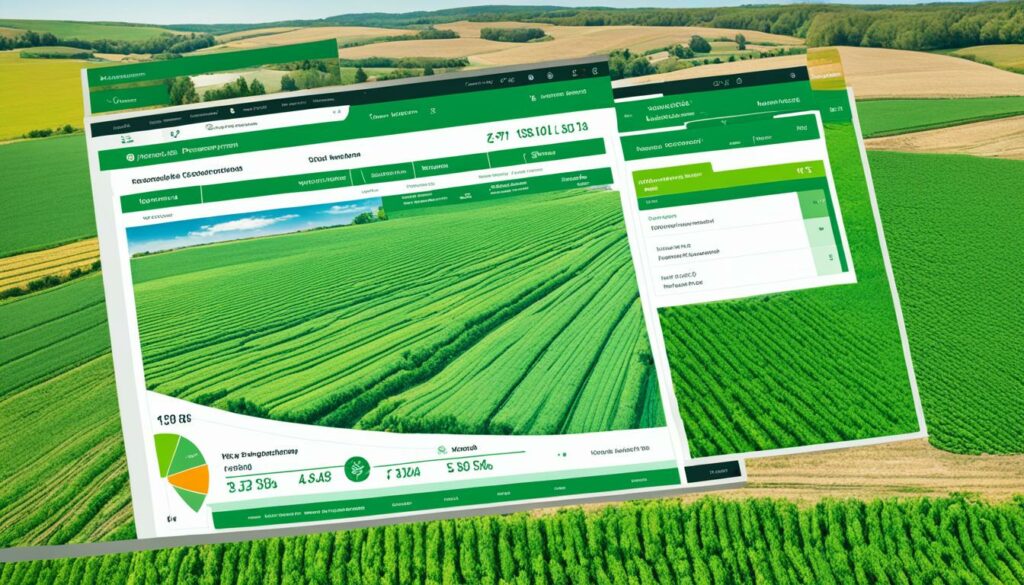
Good farm accounting software has features that make managing money easier. It comes with lots of helpful tools. These include:
Many farms worldwide trust in these software solutions. They give instant financial info and help cut costs. They’re actually known as the top farm management software. Plus, they’re simple to pick up and use, without needing a lot of training.
Budgeting well helps farms use their money wisely. Farm financial software is great at this. It offers budgeting tools that include:
There are plenty of software choices to meet various budget needs:
| Software | Starting Price | Notable Features |
|---|---|---|
| QuickBooks Online | $30/month | Industry-leading financial software |
| FarmRaise | Free / $36/month | Offline use, asset/inventory tracker, funding library |
| FarmBooks | $495/year | Offline functionality, multi-farm management |
| Xero | $15/month | User-friendliness, invoicing capabilities |
| Traction | $79/month | Reporting and data insights |
| EasyFarm | $650 | Comprehensive livestock management |
Precision agriculture applications are changing how farming works. They use top tech to make farming more efficient and earth-friendly. With digital data, farmers can choose wisely, saving money and helping the planet. Let’s look at how these new tools are bettering farming today.
Precision agriculture tech is great at saving on costs. Using GPS, farmers can plan out where to water, spot issues, and steer tractors accurately. This precision stops waste when applying fertilisers, weed killers, and water.
Geographic Information Systems (GIS) help in dividing farms into zones. This is based on soil info and other factors. With these zones, resources are used wisely. This means less waste, saving money in the long run.
Software for sustainable farming is key to helping the planet and keeping farms productive. Tools like drones keep an eye on crops without harming the environment. Drones also help by taking detailed soil readings. This makes sure pesticides are used where they’re most needed. And by using satellite pictures, farmers can see exactly who needs what. This leads to smarter farming methods.
Precision farming is about doing well economically and eco-friendly. Through sensors, drones, and satellites, farmers use their resources smartly. This helps keep farming sustainable.
Precision agriculture is changing the game. It’s not just about getting more crops. It’s also about the health of the land for the future. This makes farming better for the earth and the pocket.
This new tech in farming brings double benefits. It saves money and makes agriculture greener. This leads to a stronger farming future.
In today’s farming, sensor technology in agriculture is key to better results and preserving the land. By using smart sensors and watching field condition monitoring, farmers can act quickly and accurately.
The International Business Machines Corporation (IBM) thinks that Agricultural Monitoring Systems (AMSs) could increase production by 70% by 2050. These high-tech sensors give instant updates on important things like temperature and soil moisture. They help farmers make smart choices quickly.
One great example is Bulgin’s Agricultural Monitoring. They put an EEPROM device in a connector to protect other equipment. This makes sure data gathering stays strong, even in tough farm areas.
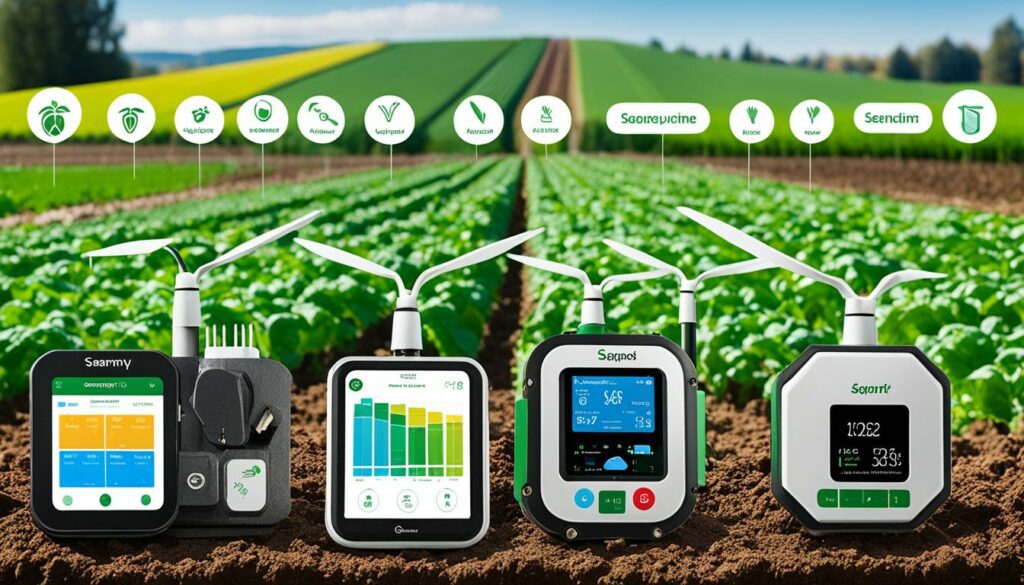
New monitoring tech is changing farming for the better. McKinsey & Company says this might add $500 billion every year to the economy. AI and predictive tech make smart use of info from these sensors.
Monarch’s WingspanAI is a star in this field. It lets farmers see live video from tractor cameras, find tractors, and know what each one is doing. This means less need for someone watching all the time. It lets farmers concentrate on important jobs like fixing things, buying what they need, and planting.
Also, tracking fuel savings and cutting carbon emissions is easier with this tech. It helps farmers plan better and see the value of their investments.
Using sensor technology in agriculture shows the best in farming today. It gives farmers the latest on their fields, helping them work better and protect the land. This leads to better crops and overall farm success over time.
Agriculture mapping software is changing the face of farming. It uses GIS, satellite data, and drones to make farming more accurate. This helps farmers deal with the challenges of growing crops more efficiently.
GIS mapping brings a host of benefits to farming. These include better decision making, smarter use of resources, and improved planning.
Adding satellite and drone technology improves farming maps even more. It offers benefits like real-time field updates and detailed crop images.
Farmers who use these advanced mapping tools can get the most out of their land. It boosts farming intelligence to a new level.
UAV farming software is changing agriculture by making crop production smarter. It does this by collecting data and watching fields from above. With drones, farmers see more of their crops without spending hours walking the fields.
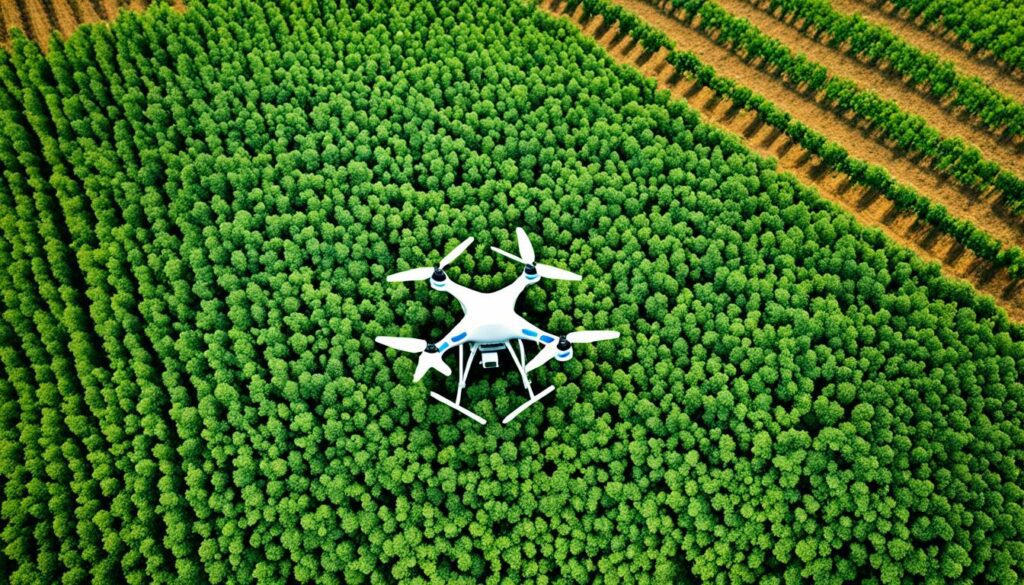
Agricultural drones create detailed maps by putting together aerial images. This makes it easier for farmers to closely study their fields. They use special cameras to check the health of plants from above. This helps them spot problems early.
A drone can take hundreds of photos quickly and makes detailed maps. These maps show where crops might be struggling, thanks to things like droughts or pests. This saves a lot of time and helps farmers take action fast.
Botlink’s NDVI maps are great because they make spotting problems easy. They are perfect for tasks like spraying or reseeding fields. Keeping track of these maps over time helps farmers do better each season.
Using drones for farm checks is cheaper than using planes or satellites. It gives farmers quick updates on their crops for better decisions. Plus, it works well with different types of drones, making it flexible.
Drone software works with top brands to analyse farm data better. It makes farm work smoother and helps people share notes easily. This means farmers, clients, and workers can talk and plan together better.
Drone software also helps check fields fast and accurately. It processes drone data quickly and can even spot where chemicals are needed. This saves money and helps protect the environment.
This software can make maps without needing to be online. This is great for finding crop damage fast. It helps everyone in farming, including those who work in farming research, act quickly.
The Botlink software is very fast, which is great for farmers who need results now. It can share maps easily, keeping everyone in the know right away.
UAV farming software is changing the way farms are run. It makes farming smarter and more efficient. Drones are really making a big impact in farming.
McKinsey analysts call the world’s food producers the “least digitised industry.” This makes the move to custom digital farming tools very important. Tailoring these tools to meet specific farm needs can greatly increase productivity and help the environment.
By 2025, the total data stored worldwide will be 175 zettabytes. Digital farm tools use this huge amount of information. For instance, SoilOptix® helps farmers by providing precise soil analysis and advice on crop management that’s just for their farm.
Products like xarvio use 25 years of know-how in crop modelling. Xarvio helps farmers in Europe, Latin America, and North America with advice tailored to their fields. Their Zone spray feature is very exact, recommending the correct amount to avoid waste.
Custom tech like drones and sensors give farmers detailed updates on the weather, moisture levels in the soil, and the status of crops. This helps them act on real-time data, cutting down on waste and improving their profits.
Use of these bespoke digital solutions in farming reduces waste and improves the environment. For instance, xarvio HEALTHY FIELDS helps farmers by ensuring leaf health through better use of products. It offers refunds if the outcome doesn’t meet expectations. This is the kind of value tailored agribusiness can bring.
Agricultural robotics are already worth over $5 billion and will keep growing. They will work even better with the increasing use of technologies like IoT, sensors, AI, and cloud computing. These advanced digital farm tools are making farming more efficient and innovative than ever.
Using tech designed for each farm tackles the specific challenges of farming today. It leads to greater productivity and helps make farming more sustainable.
Adding IoT to farming is changing the game. The market for this tech is growing fast, from $11.5 billion in 2021 to $32.8 billion by 2032. This growth is helping farmers use data in new ways and making their work more efficient.

Big companies like Bayer AG and John Deere are leading in IoT use. Bayer’s Climate FieldView Platform and John Deere’s machines both use IoT to boost farming. They aim to make farming smarter with better field maps and crop care.
Gathering data immediately is key for managing farms well. New tech like AI and drones are helping with this. They let farmers use data quickly to make better choices. For example, products like Field Margin help with mapping and managing crops.
Agriculture wins big with IoT, through savings and a greener approach. But, there are issues to address, such as cost and security. Smart solutions and new uses for IoT are making farming smarter, though.
Streamlining farm operations is key to boost productivity and work towards a sustainable way of farming. Using digital tools and automation is crucial. It changes how we document things and saves money, making farming better today.
Automated documentation cuts down time needed for admin tasks on the farm. Software helps with scheduling tasks like watering and planting. This saves time, improves accuracy, and makes decision-making smarter. It also helps teams work together better, which is super helpful on bigger farms.
Making farming cheaper without lowering quality is key to making more profit. Software helps manage money by keeping track of spending and budgeting better. It offers timely weather updates to plan the work efficiently. With flexible pricing, farms can pick what they need. xFarm, for example, starts at €195 a year and is available in seven languages. It uses modern agricultural technology to cut the manual work and make better decisions.
| Feature | Benefit |
|---|---|
| Automation of Routine Tasks | Time-saving, error reduction, enhanced efficiency |
| Data Collection & Analysis | Informed decisions, improved productivity |
| Enhanced Communication | Better team collaboration, particularly in larger farms |
| Financial Management | Tracking expenses, generating reports, budget management |
| Accurate Weather Forecasting | Real-time updates, better planning |
| Modular Pricing | Economic adoption of digital tools |
| Advanced Technologies (e.g., IoT, Satellite Imagery) | Operational streamlining, reduced manual work |
The farming world is adopting digital tools to advance work and cut down on long tasks. EOSDA Crop Monitoring and 365FarmNet shine in this crowd, offering a bunch of useful features. These include tracking crops, managing fields, and connecting with other farm machines. They are helping farmers everywhere work smarter and get more done.
EOSDA Crop Monitoring is a top choice for farmers. It has cool features like checking fields from space, tracking plant growth, and watching moisture levels in the soil. A 2015 study by Fountas, S. and team pointed out the big benefit of using systems like EOSDA. They said it boosts how much farmers can produce. EOSDA can follow data for up to 300 fields closely, giving farmers detailed and real-time info. This helps farms of all sizes, from small ones on a tight budget to big ones wanting to be more efficient.
365FarmNet is also known for its great work in helping farmers manage their land better. It shines in using data from things like drones and satellites to make smart choices. This is big, as experts like Pierce, F.G. and Clay, D. have stressed the importance of this kind of mapping in farming. The field of agricultural software is on track to grow from $10.5 billion to $22.5 billion by 2025. This shows a bright future for tools like 365FarmNet, which will stay key for farmers.
To wrap up, advanced tools like EOSDA Crop Monitoring and 365FarmNet are changing how farms are run. They blend well with new farming methods, pushing agriculture towards more efficiency and sustainability.
Custom digital tools, like special agtech services, meet the needs of farms directly. They help improve every farm’s operation by tackling specific challenges. This makes work smoother, more productive, and efficient for each farmer.
Digital tools make farming more efficient and productive. They use resources better, increase crop yields, and help in making smart decisions. Farming operations can then be managed automatically. This leads to more sustainable and profitable farming practices.
Agriculture software includes many types, like farm management and precision agriculture apps. These help improve how farms work, by making them more efficient and keeping finances in check.
Agriculture software offers many benefits, including better control over management and quicker decisions. It also centralises data. This helps with activities like maintaining records, managing water, and controlling pests. The end result is more efficient farms that earn more profit.
Crop management tools give insight into plant growth and what to expect from crops. They use real-time data to look at plant health and the environment. This allows farmers to make improvements as needed, ensuring good harvests and continuous productivity.
Farm financial software has special features for agricultural accounting. It helps with inventory, tracking costs, and managing income and expenses. This leads to better financial control and more cost-effective farming.
Precision agriculture apps help farms spend less by using digital data. They make farming more eco-friendly and efficient by using data about the environment, soil, and plants. This allows for precise use of chemicals and managing resources well, which is good for the economy and nature.
Sensors are key in keeping fields in check. They give farmers detailed info on soil and plants. This helps farmers take steps when needed, which boosts crop health and output.
GIS mapping helps with accurate location info for planting, fertilising, and harvesting. It uses satellite and drone data for informed decisions. This makes farming smarter and more efficient.
Drone software does aerial tasks, like checking crops and collecting data. Drones give farmers fresh insights, leading to more efficient crop production and lower costs.
IOT makes farming data collection and analysis fast and easy. It enhances how farms are managed, making them more efficient and sustainable.
Efficient operations lower admin work and costs. This saves time and resources, letting farmers focus on growing their farms. It makes the whole farm run better.
Top agriculture software, like EOSDA Crop Monitoring and 365FarmNet, are praised for cloud-based precision and detailed records. These help with field work, scouting, and integrating with farm machinery. They are changing how farming works for the better.